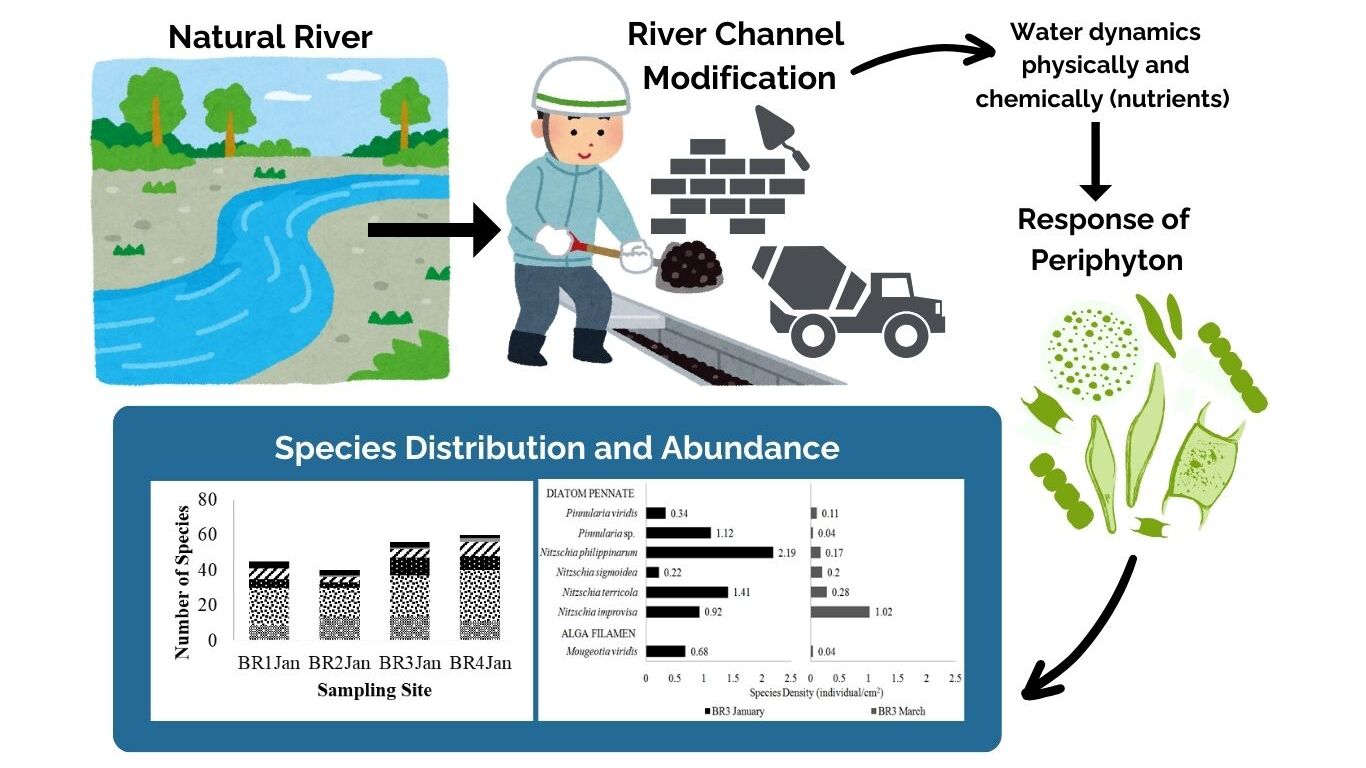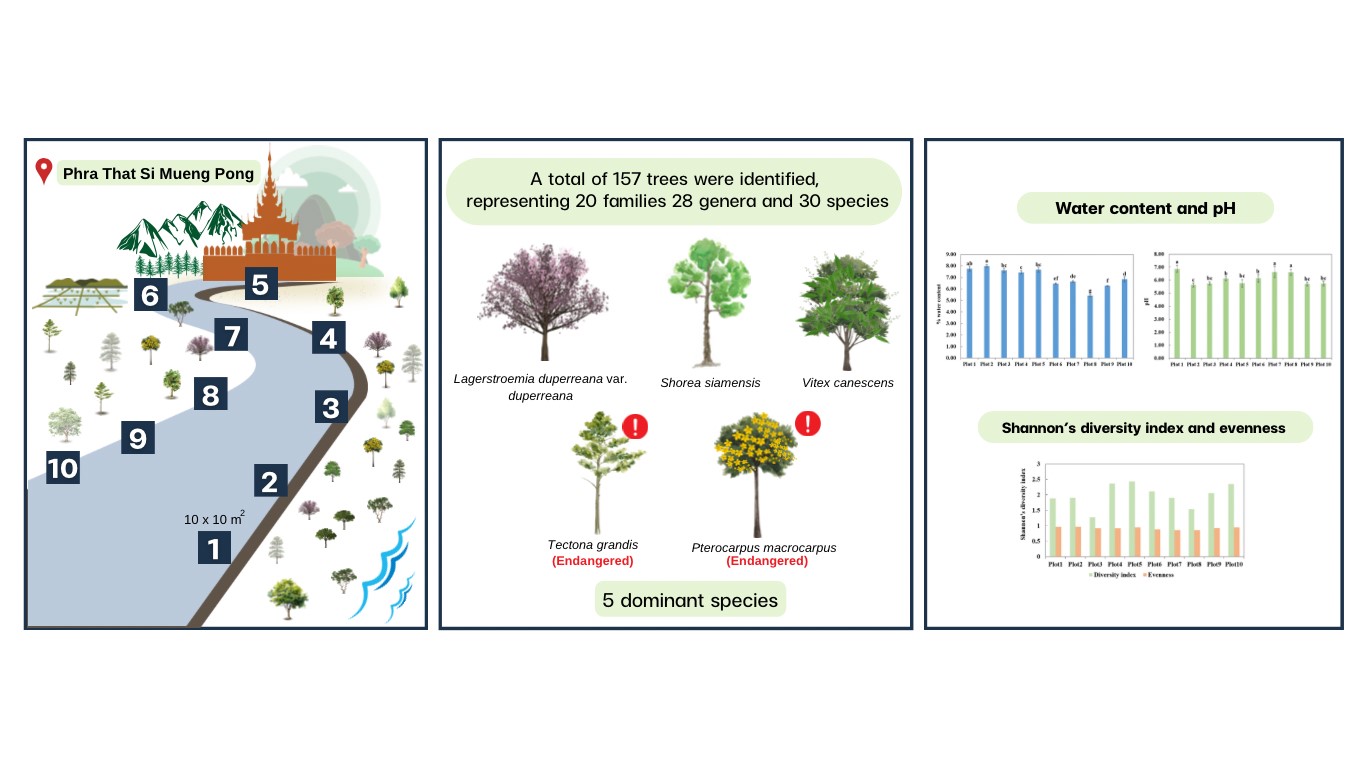ECOLOGICAL EFFECTS OF BELIK RIVER HYDRAULIC CHARACTERISTICS ON PERIPHYTON COMMUNITY AS WATER QUALITY BIOINDICATOR

Downloads
ARTICLE HIGLIGHTS
- Differences in river hydraulic characteristics affect ecological river health
- The influence of flooding on the dynamics of physical and chemical characteristics of river water
- Life strategy, adaptation of periphyton to environmental changes
- Development of green infrastructure for river conservation
ABSTRACT
Belik River is one of the urban rivers in the Special Region of Yogyakarta which has hydrological problems both in quantity and quality. This triggered the construction of various types of channel modifications. This study aimed to identify water quality and the ecological effects of channel modifications based on the presence of periphyton communities as bioindicators. Sampling was carried out in January 2021 and March 2021. Samples were taken at 4 sampling sites with different channel characteristics with 3 repetitions at each location. The physico-chemical parameters measured included pH, detergent, nitrate, sulfate, total phosphate, TSS, TDS, DO, CO2, water temperature, depth, transparency, discharge, and current velocity. The results showed that the abundance of periphyton in January 2021 was higher than in March 2021. In January 2021 there were found 91 periphyton species dominated by Nitzschia improvisa, Nitzschia terricola, and Nitzschia philippinarum. Meanwhile, in March 2021 there were found 61 species of periphyton dominated by Nitzschia improvisa. Based on the results of Canonical Correlation Analysis (CCA), it was shown that in general the distribution and abundance of periphyton in the Belik River were influenced by CO2, total phosphate, discharge, DO, nitrate, TSS, and depth. The Shannon Wiener Diversity Index showed that water quality in January 2021 has decreased in March 2021. From the cluster analysis, it is known that there are differences in water quality and abundance of periphyton in the four types of river channels. It can be concluded that differences in hydraulic characteristics affected water quality and the ecological health of Belik River.
Downloads
Amoatey P, Baawain MS. 2019. Effects of pollution on freshwater aquatic organisms. Water Environ Res 91(10):1272-87. DOI: https://doi.org/10.1002/wer.1221
APHA. 1998. Standard methods for the examination of water and wastewater 20th Edition. Washington DC (US): American Public Health Association.
Bahri S, Maliga I. 2018. Pengaruh organisme perifiton dalam memperbaiki kualitas air pada lahan basah buatan sistem aliran air permukaan bebas. [The effect of periphyton organisms in repairing water quality in artificial wetlands free surface runoff systems]. Jurnal Sumber Daya Air 14(1):1-14. DOI: https://doi.org/10.32679/jsda.v14i1.289
Biranje SS, Nathany A, Mehra N, Adivarekar R. 2015. Optimisation of detergent ingredients for stain removal using statistical modelling. J Surfactants Deterg 18:949-956. DOI: https://doi.org/10.1007/s11743-015-1722-6
Butler BA, Ford RG. 2018. Evaluating relationships between Total Dissolved Solids (TDS) and Total Suspended Solids (TSS) in a mining-influenced watershed. Mine Water Environ 37(1):18-30. DOI: https://doi.org/10.1007/s10230-017-0484-y
Environmental Protection Agency (EPA). 2012. Periphyton protocols. Washington DC (US): Watershed Academy Web.
Franklin SB, Kupfer JA, Pezeshki SR, Gentry R, Smith RD. 2009. Complex effects of channelization and levee construction on Western Tennessee floodplain forest function. WETLANDS 29(2):451-64. DOI: https://doi.org/10.1672/08-59.1
Harisnor A, Amalia M. 2016. Analisa parameter hidraulik pada Sungai Veteran Kota Banjarmasin. [Analysis of hydraulic parameters in Veteran River Banjarmasin City]. Jurnal Poros Teknik 8(2):55-103. DOI: https://doi.org/10.31961/porosteknik.v8i2.374
Hossain MG, Reza AHMS, Nessa ML, Ahmed SS. 2013. Factor and cluster analysis of water quality data of the groundwater Wells of Kushtia, Bangladesh: Implication for arsenic enrichment and mobilization. J Geol Soc India 81:377-84. DOI: https://doi.org/10.1007/s12594-013-0048-0
Hoyle JT, Kilroy C, Hicks DM, Brown L. 2016. The influence of sediment mobility and channel geomorphology on periphyton abundance. Freshw Biol 62(2):258-73. DOI: https://doi.org/10.1111/fwb.12865
Kemalasari D, Chosin DN. 2011. Relationship different riparian vegetation cover with stream conditions in Cikapinis Stream, West Jawa. Jurnal Biologi Indonesia 7(2):231-42.
Kennedy TL, Turner TF. 2011. River channelization reduces nutrient flow and macroinvertebrate diversity at the aquatic terrestrial transition zone. Ecosphere 2(3):1-13. DOI: https://doi.org/10.1890/ES11-00047.1
Kent M, Paddy C. 1992. Vegetation description and analysis a practical approach. London (UK): Belhaven Press.
Kukuryk MT, Mieczan T. 2012. Effect os substrate on periphyton communities and relationships among food web components in shallow hypertrophic lake. J Limnol 71(2):53-64. DOI: https://doi.org/10.4081/jlimol.2012.e30
Larned ST. 2010. A prospectus for peripthyton : Recent and future ecology research. SFS 29(1):182-206. DOI: https://doi.org/10.1899/08-063.1
Lennox PA, Rasmussen JB. 2016. Long-term effects of channelization on a cold-water stream community. Can J Fish Aquat Sci 73:1-8. DOI: https://doi.org/10.1139/cjfas-2015-0561
Lumuan MD, Sujono J, Supraba I. 2017. Pola penanganan genangan air hujan dengan pendekatan konsep blue green cities di kawasan Kampus UGM. [Patterns for dealing with puddles rain with a blue green city concept approach in the UGM campus area]. Jurnal Teknisia 22(2).
Manickavasagam S, Sudhan C, Bharathi, Aanand S. 2019. Bioindicators in aquatic environment and their significance. J Aquacult Trop 34(1):73-9. DOI: https://doi.org/10.32381/JAT.2019.34.1-2.6
Mekonnen MM, Hoekstra AY. 2018. Global anthropogenic phosphorus loads to fresh water and associated grey water footprints and water pollution levels: A high-resolution global study. Water Resour Res 54(1):345-58. DOI: https://doi.org/10.1002/2017WR020448
Mubarok LR, Suprayogi S. 2018. Kajian karakteristik pencemar bagian hulu Sungai Belik, Daerah Istimewa Yogyakarta. [Study of the Belik River, Daerah Istimewa Yogyakarta upstream contaminants characteristics]. Jurnal Bumi Indonesia 7(4):1-9.
Olszynski RM, Wieczorek JZ. 2018. Aulacoseira pseudomuzzanensis sp. nov. and other centric diatoms from post iron ore mining reservoirs in Poland. Diatom Res 33(2):155-85. DOI: https://doi.org/10.1080/0269249X.2018.1509886
Pal S, Das D, Chakraborty K. 2015. Colour optimization of the secchi disk and assessment of the water quality in consideration of light extinction coefficient of some selected water bodies at Cooch Behar, West Bengal. Int Multidiscip Res J 2(3):513-8.
Puijenbroek PJTM, Beusen AHW, Bouwman AF. 2018. Datasets of the phosphorus content in laundry and dishwater detergent. Data in Brief 21:2284-9 DOI: https://doi.org/10.1016/j.dib.2018.11.081
Rashid R, Bhat RA, Pandit AK, Bhat S. 2013. Ecological study of pheriphytic algal community of Doodh Ganga and Khansha-Mansha Streams of Yusmarg Forest: A health resort of Kashmir Valley, India. Ecol 5(1):9-19.
Rier ST, Stevenson RJ. 2006. Response of periphytic algaeto gradients in nitrogen and phosphorus in streamside mesocosms. Hydrobiologia 561:131-47. DOI: https://doi.org/10.1007/s10750-005-1610-6
Singh M, Parikh P. 2020. Freshwater diatoms as bio-indicators in urban wetlands of Central Gujarat, India. Indian J Ecol 47(1):7-11.
Singh S, James A, Bharose R. 2017. Biological assesment of water pollution using periphyton productivity: a review. Nat Environ Pollut 16(2):559-67.
Suprayogi S, Fatchurohman H, Widyastuti M. 2019. Analisis kondisi hidrologi terhadap perkembangan wilayah perkotaan studi kasus DAS Kali Belik Yogyakarta. [Hydrology condition analysis for urban area, a case study of the Belik River watershed, Yogyakarta]. Jurnal Geografi 16(2):153-61.
Swanson S, Kozlowski D, Hall R, Heggem D, Lin J. 2017. Riparian proper functioning condition assessment to improve watershed management for water quality. J Soil Water Conserv 72(2):168-82. DOI: https://doi.org/10.2489/jswc.72.2.168
Tofani AS, Hadi MP. 2020. Total maximum daily load of BOD in urbanized Belik River, Yogyakarta. IOP Conf Ser Earth Environ Sci 451. DOI: https://doi.org/10.1088/1755-1315/451/1/012078
Ummi F, Retnaningdyah C, Yanuwiadi B. 2019. The role of riparian vegetation in secondary irrigation channels at Slamet Village, Tumpang District, Malang Regency to improve irrigation water quality. Resour Environ 9(3):65-70.
Utami ND, Suprayogi S. 2014. Kajian debit banjir akibat perubahan penggunaan lahan di Sub DAS Belik, Daerah Istimewa Yogyakarta. [Study of flood discharge due to land use change in Belik River, Special Region of Yogyakarta]. Jurnal Bumi Indonesia 3(3):1-10.
Venkateswarlu T, Anmala J, Dharwa M. 2020. PCA, CCA, and ANN modelling of climate and land-use effects on stream water quality of karst watershed in Upper Green River, Kentucky. J Hydrol Eng 25(6). DOI: https://doi.org/10.1061/(ASCE)HE.1943-5584.0001921
Walalite T., Dekker SC, Keizer FM, Kardel I, Schot PP, deJong SM, Wassen MJ. 2016.
Flood water hydrochemistry patterns suggest floodplain sink function for dissolved solids from the songkhram Monsoon River (Thailand). Wetlands 36:995-1008. DOI: https://doi.org/10.1007/s13157-016-0814-z
Wang M, Cheng W, Wan T, Meng T, Hao ZJ, Shi LD. 2018. Effects of water ecological environment on benthic algae in a water source reservoir. IOP Conf Ser Earth Environ Sci 191. DOI: https://doi.org/10.1088/1755-1315/191/1/012056
Whorley SB, Wehr JD. 2016. Flood events can reduce key fatty acid content of early-stage benthic algal assemblages in an urban stream. J Urban Ecol 2(1):1-12. DOI: https://doi.org/10.1093/jue/juw002
Copyright (c) 2023 Heni Sartika, Suwarno Hadisusanto, Muhammad Sulaiman

This work is licensed under a Creative Commons Attribution-NonCommercial-NoDerivatives 4.0 International License.
Authors who publish with this journal agree with the following terms:
- Authors retain copyright and grant the journal right of first publication, with the work 1 year after publication simultaneously licensed under a Creative Commons attribution-noncommerical-noderivates 4.0 International License that allows others to share, copy and redistribute the work in any medium or format, but only where the use is for non-commercial purposes and an acknowledgement of the work's authorship and initial publication in this journal is mentioned.
- Authors are able to enter into separate, additional contractual arrangements for the non-exclusive distribution of the journal's published version of the work (e.g., post it to an institutional repository or publish it in a book), with an acknowledgement of its initial publication in this journal.
- Authors are permitted and encouraged to post their work online (e.g., in institutional repositories or on their website) prior to and during the submission process, as it can lead to productive exchanges, as well as earlier and greater citation of published work (See The Effect of Open Access).




























